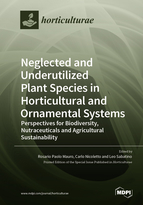Neglected and Underutilized Plant Species in Horticultural and Ornamental Systems: Perspectives for Biodiversity, Nutraceuticals and Agricultural Sustainability
A special issue of Horticulturae (ISSN 2311-7524). This special issue belongs to the section "Medicinals, Herbs, and Specialty Crops".
Deadline for manuscript submissions: closed (31 December 2021) | Viewed by 67629
Special Issue Editors
Interests: agronomic management in horticulture and floriculture; breeding of horticultural crops; crop physiology; vegetables quality; secondary metabolites
Special Issues, Collections and Topics in MDPI journals
Interests: modeling; plant physiology; statistical analysis; genetic diversity; food chemistry; irrigation; plant biology; predictive modeling; plant breeding
Special Issues, Collections and Topics in MDPI journals
Interests: vegetable production; vegetable grafting; soilless cultivation; nutritional and nutraceutical vegetable fruit quality linked to cultivation conditions and practices; biofortification of leafy and fruiting vegetable crops, propagation of ornamental plants
Special Issues, Collections and Topics in MDPI journals
Special Issue Information
Dear Colleagues,
We are pleased to announce this Special Issue of Horticulturae, dedicated to the multifaceted topic of neglected and underutilized plant species (NUS) in horticultural and ornamental systems. Over the last few decades, this topic has received growing attention from the scientific community, as a possible option to face the agricultural challenges of producing more foods and services, within a framework of greater sustainability. Indeed, global urbanization processes, climate change, and the reduction of natural resources are expected to emphasize the vulnerability of mainstream agriculture, satisfying the needs of an ever-increasing world population by leveraging a restricted number of cash crops. In this context, NUS could promote agro-biodiversity, improve the resilience of the agro-ecosystems toward environmental stressors, foster the utilization of nutraceuticals and the diversification of dietary patterns, and provide important local services (environmental, economical, socio-cultural) as ornamentals or in landscapes. However, there are still manifold barriers hampering increased NUS utilization out of their niche role, many of which stem from our poor knowledge about their biological and technical features.
For the above reasons, this Special Issue will contribute to filling knowledge gaps about NUS in horticultural and ornamental systems, as well as in landscapes by encouraging the submission of original research papers, short communications, and review articles dealing with their relevance to the following:
- Biodiversity and conservation
- Genetics and breeding
- Characterization, propagation, and ecophysiology
- Cultivation techniques and systems
- Landscape protection and restoration
- Product and process innovations
- Biochemistry and composition
- Postharvest factors affecting their end-use quality
Papers concerning neglected or underutilized landraces within major horticultural/ornamental species are welcome too.
Dr. Rosario Paolo Mauro
Dr. Carlo Nicoletto
Dr. Leo Sabatino
Guest Editors
Manuscript Submission Information
Manuscripts should be submitted online at www.mdpi.com by registering and logging in to this website. Once you are registered, click here to go to the submission form. Manuscripts can be submitted until the deadline. All submissions that pass pre-check are peer-reviewed. Accepted papers will be published continuously in the journal (as soon as accepted) and will be listed together on the special issue website. Research articles, review articles as well as short communications are invited. For planned papers, a title and short abstract (about 100 words) can be sent to the Editorial Office for announcement on this website.
Submitted manuscripts should not have been published previously, nor be under consideration for publication elsewhere (except conference proceedings papers). All manuscripts are thoroughly refereed through a single-blind peer-review process. A guide for authors and other relevant information for submission of manuscripts is available on the Instructions for Authors page. Horticulturae is an international peer-reviewed open access monthly journal published by MDPI.
Please visit the Instructions for Authors page before submitting a manuscript. The Article Processing Charge (APC) for publication in this open access journal is 2200 CHF (Swiss Francs). Submitted papers should be well formatted and use good English. Authors may use MDPI's English editing service prior to publication or during author revisions.








